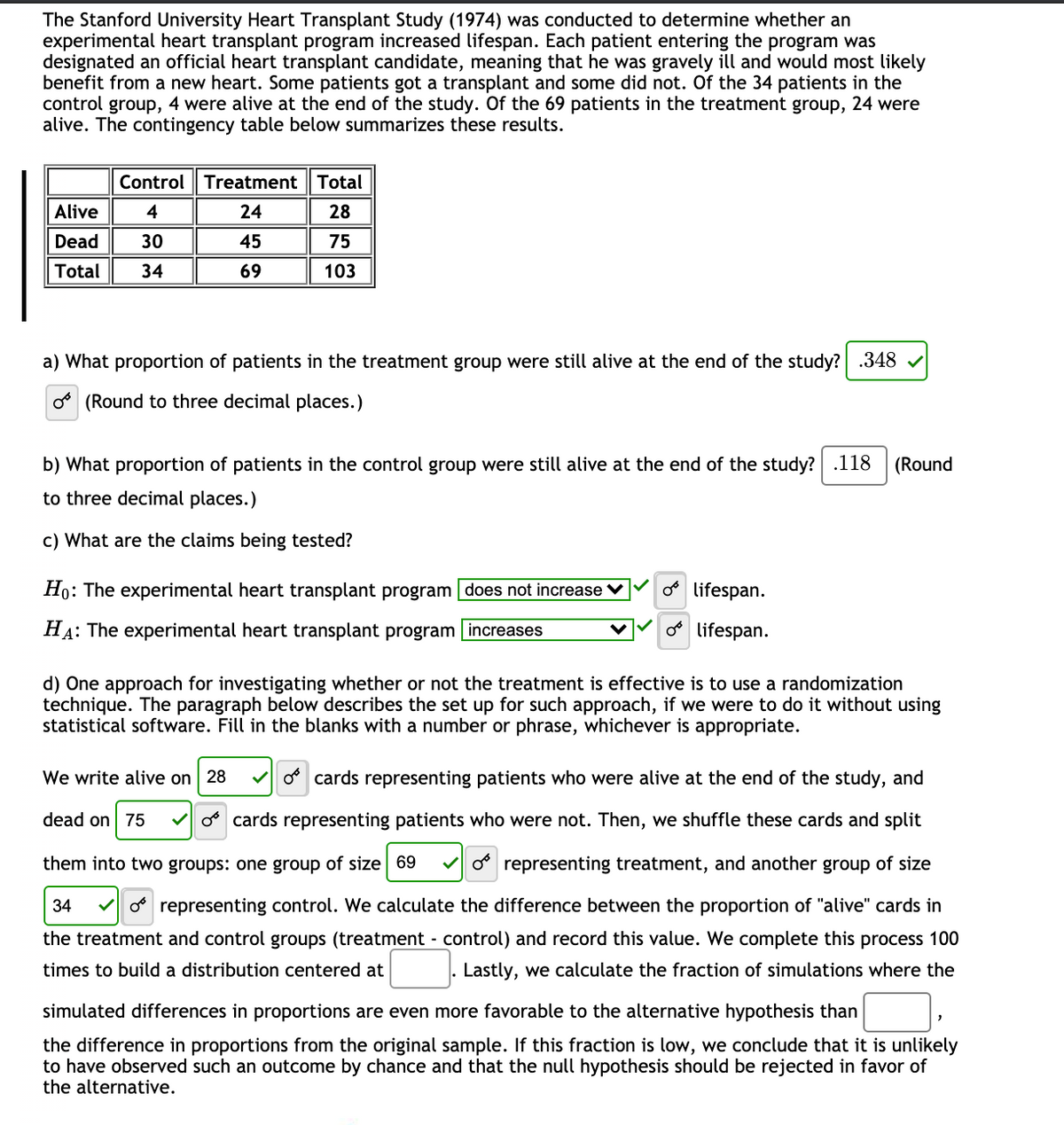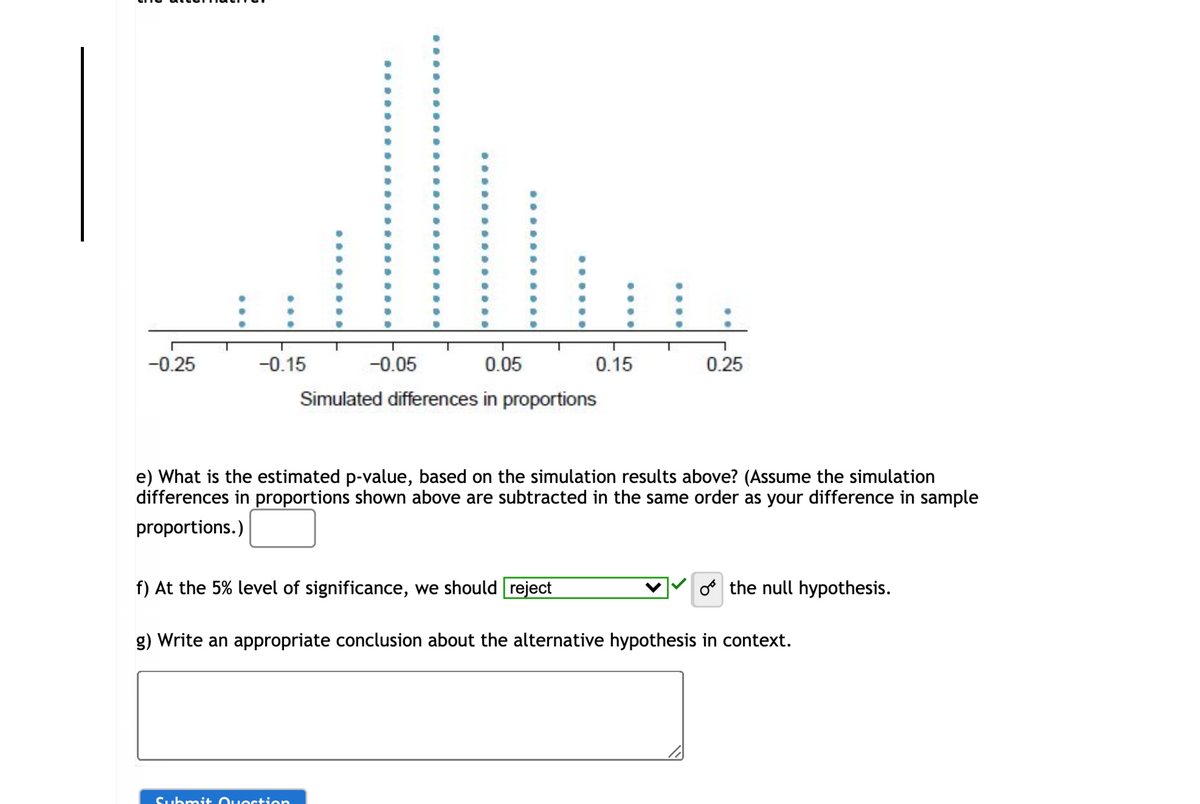*BOLD MEANS I NEED HELP ON THIS SECTION. PLEASE LOOK AT IMAGES. The Stanford University Heart Transplant Study (1974) was conducted to determine whether an experimental heart transplant program increased lifespan. Each patient entering the program was designated an official heart transplant candidate, meaning that he was gravely ill and would most likely benefit from a new heart. Some patients got a transplant and some did not. Of the 34 patients in the control group, 4 were alive at the end of the study. Of the 69 patients in the treatment group, 24 were alive. The contingency table below summarizes these results. Control Treatment Total Alive 4 24 28 Dead 30 45 75 Total 34 69 103 a) What proportion of patients in the treatment group were still alive at the end of the study? .348Correct (Round to three decimal places.) b) What proportion of patients in the control group were still alive at the end of the study? .118 (Round to three decimal places.) c) What are the claims being tested? H0H0: The experimental heart transplant program Select an answer increases does not increase Correct lifespan. HAHA: The experimental heart transplant program Select an answer increases does not increase Correct lifespan. d) One approach for investigating whether or not the treatment is effective is to use a randomization technique. The paragraph below describes the set up for such approach, if we were to do it without using statistical software. Fill in the blanks with a number or phrase, whichever is appropriate. We write alive on Correct cards representing patients who were alive at the end of the study, and dead on Correct cards representing patients who were not. Then, we shuffle these cards and split them into two groups: one group of size Correct representing treatment, and another group of size Correct representing control. We calculate the difference between the proportion of "alive" cards in the treatment and control groups (treatment - control) and record this value. We complete this process 100 times to build a distribution centered at _____?Lastly, we calculate the fraction of simulations where the simulated differences in proportions are even more favorable to the alternative hypothesis than________? the difference in proportions from the original sample. If this fraction is low, we conclude that it is unlikely to have observed such an outcome by chance and that the null hypothesis should be rejected in favor of the alternative. e) What is the estimated p-value, based on the simulation results above? (Assume the simulation differences in proportions shown above are subtracted in the same order as your difference in sample proportions.) g) Write an appropriate conclusion about the alternative hypothesis in context.
*BOLD MEANS I NEED HELP ON THIS SECTION. PLEASE LOOK AT IMAGES.
The Stanford University Heart Transplant Study (1974) was conducted to determine whether an experimental heart transplant program increased lifespan. Each patient entering the program was designated an official heart transplant candidate, meaning that he was gravely ill and would most likely benefit from a new heart. Some patients got a transplant and some did not. Of the 34 patients in the control group, 4 were alive at the end of the study. Of the 69 patients in the treatment group, 24 were alive. The contingency table below summarizes these results.
| Control | Treatment | Total | |
| Alive | 4 | 24 | 28 |
| Dead | 30 | 45 | 75 |
| Total | 34 | 69 | 103 |
a) What proportion of patients in the treatment group were still alive at the end of the study? .348Correct (Round to three decimal places.)
b) What proportion of patients in the control group were still alive at the end of the study? .118 (Round to three decimal places.)
c) What are the claims being tested?
H0H0: The experimental heart transplant program Select an answer increases does not increase Correct lifespan.
HAHA: The experimental heart transplant program Select an answer increases does not increase Correct lifespan.
d) One approach for investigating whether or not the treatment is effective is to use a randomization technique. The paragraph below describes the set up for such approach, if we were to do it without using statistical software. Fill in the blanks with a number or phrase, whichever is appropriate.
We write alive on Correct cards representing patients who were alive at the end of the study, and dead on Correct cards representing patients who were not. Then, we shuffle these cards and split them into two groups: one group of size Correct representing treatment, and another group of size Correct representing control. We calculate the difference between the proportion of "alive" cards in the treatment and control groups (treatment - control) and record this value. We complete this process 100 times to build a distribution centered at _____?Lastly, we calculate the fraction of simulations where the simulated differences in proportions are even more favorable to the alternative hypothesis than________? the difference in proportions from the original sample. If this fraction is low, we conclude that it is unlikely to have observed such an outcome by chance and that the null hypothesis should be rejected in favor of the alternative.
e) What is the estimated p-value, based on the simulation results above? (Assume the simulation differences in proportions shown above are subtracted in the same order as your difference in sample proportions.)
g) Write an appropriate conclusion about the alternative hypothesis in context.


Trending now
This is a popular solution!
Step by step
Solved in 4 steps with 1 images









